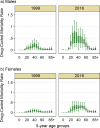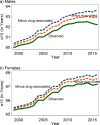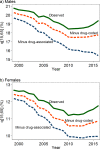Estimating the impact of drug use on US mortality, 1999-2016
- PMID: 31940370
- PMCID: PMC6961845
- DOI: 10.1371/journal.pone.0226732
Estimating the impact of drug use on US mortality, 1999-2016
Abstract
The impact of rising drug use on US mortality may extend beyond deaths coded as drug-related to include excess mortality from other causes affected by drug use. Here, we estimate the full extent of drug-associated mortality. We use annual death rates for 1999-2016 by state, sex, five-year age group, and cause of death to model the relationship between drug-coded mortality-which serves as an indicator of the population-level prevalence of drug use-and mortality from other causes. Among residents aged 15-64 living in the 50 US states, the estimated number of drug-associated deaths in 2016 (141,695) was 2.2 times the number of drug-coded deaths (63,000). Adverse trends since 2010 in midlife mortality are largely attributable to drug-associated mortality. In the absence of drug use, we estimate that the probability of dying between ages 15 and 65 would have continued to decline after 2010 among men (to 15% in 2016) and would have remained at a low level (10%) among women. Our results suggest that an additional 3.9% of men and 1.8% of women died between ages 15 and 65 in 2016 because of drug use. In terms of life expectancy beyond age 15, we estimate that drug use cost men 1.4 years and women 0.7 years, on average. In the hardest-hit state (West Virginia), drug use cost men 3.6 and women 1.9 life years. Recent declines in US life expectancy have been blamed largely on the drug epidemic. Consistent with that inference, our results imply that, in the absence of drug use, life expectancy at age 15 would have increased slightly between 2014 and 2016. Drug-associated mortality in the US is roughly double that implied by drug-coded deaths alone. The drug epidemic is exacting a heavy cost to American lives, not only from overdoses but from a variety of causes.
Conflict of interest statement
The authors have declared that no competing interests exist.
Figures




References
-
- Shiels MS, Berrington de Gonzalez A, Best AF, Chen Y, Chernyavskiy P, Hartge P, et al. Premature mortality from all causes and drug poisonings in the USA according to socioeconomic status and rurality: an analysis of death certificate data by county from 2000–15. Lancet Public Health. 2019. February;4(2): e97–e106. 10.1016/S2468-2667(18)30208-1 - DOI - PMC - PubMed
-
- National Center for Health Statistics. Overdose death rates. Tabulations of data from CDC Wonder. Available: https://www.drugabuse.gov/related-topics/trends-statistics/overdose-deat....
-
- Walker ER, Pratt LA, Schoenborn CA, Druss BG. Excess mortality among people who report lifetime use of illegal drugs in the United States: A 20-year follow-up of a nationally representative survey. Drug Alcohol Depend. 2017. February 1;171: 31–8. 10.1016/j.drugalcdep.2016.11.026 - DOI - PMC - PubMed

